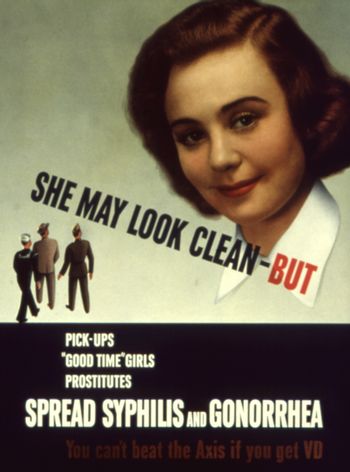"Venereal Disease" is an archaic (meaning popular in the past, but now out of date) term for "sexually transmitted infection."
Millions of Americans moved during the war. They left small towns, rural counties, and tightly-knit ethnic neighborhoods. Teenagers from homes that had strict cultures of "chaperoned" dating found much more personal freedom during the war years; parents were in the military or working overtime. There were fewer police officers and school-affiliated authority figures during the war.
Some of the data about sexually transmitted infections in major west coast cities in 1942 and 1943:
- In the fall of 1942, the San Diego Citizen's Committee to Control Venereal Disease convinced the city's police department to test every arrested sex worker, and quarantine any infected sex worker until "cured." But labor shortages in public health and the police department made it almost impossible to contain sexually transmitted disease in the city.
- In San Francisco, the sexually transmitted disease rate in 1942 and 1943 shot up by more than 75%. The city's health department operated four of the fourteen sexually transmitted infection clinics available in the city, and offered free diagnosis and treatment.
- The SF Police Department organized a major campaign to curb the sex worker trade. The city created a new curfew for minors in public places, and opened a new women's detention center in 1943 equipped to examine women suspected of being sex workers. Mayor Angelo Rossi proposed new laws that would punish hotel clerks, taxi drivers, and bar bouncers who facilitated clients for sex workers. However, those laws were not implemented.
- Seattle experienced the nation's largest epidemic of sexually transmitted infections in 1943, causing the biggest slowdowns in the nation's biggest shipyards. The city's Health Department staff was so depleted that it had to borrow personnel from the United States Public Health Service. After opening several new treatment centers, the epidemic was brought under control by 1944.
The following poster was common in defense plants in 1943: "She May Look Clean"
How could you make a case, like a lawyer talking to a jury, that "She May Look Clean" poster cannot be separated from its time?
Why was that poster a common sight in 1943?
What real-life events and practices does that poster show?
- Write a discussion post of 300-400 words (and maybe even break down into two paragraphs) and do a 3C and Q for another student's postYour discussion post will comment on what the content on that page shows about common patterns, assumptions and hierarchies about work, sexuality, gender roles, and public health inside the US during World War Two.
Give specific information and examples about the following questions: What assumptions about gender and sexuality does the poster show? What kind of public health crisis did west-coast cities face? How did local government respond? What issues about gender - the expectations a society has about how women and men behave - does the topic of sexually transmitted infections show about that time in US history?

Trending nowThis is a popular solution!
Step by stepSolved in 3 steps
